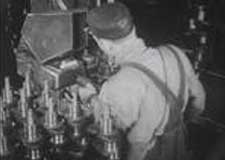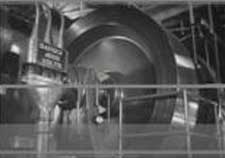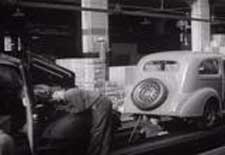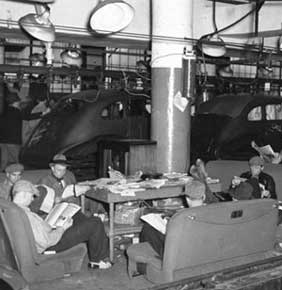 Master Hands (1936) is a half-hour documentary filmed in Flint, Michigan, immediately before automobile workers won recognition for their union. It was a Chevrolet-funded celebration of workers, an example of "capitalist realism," now on the National Film Registry of films of culturally significant films.
Master Hands (1936) is a half-hour documentary filmed in Flint, Michigan, immediately before automobile workers won recognition for their union. It was a Chevrolet-funded celebration of workers, an example of "capitalist realism," now on the National Film Registry of films of culturally significant films.
It was produced by the Jam Handy Organization which specialized in industrial films but no director is credited, though cinematographer Gordon Avil & producer Jamison Handy were defacto joint directors.
It's a celebration not only of the workers but of autombile manufacturing equipment, presses, tools, although the main feature throughout are the faces & hands of skilled men who make the tools, use the tools, & assemble the cars. It climaxes very naturally with the finished vehicle.
 Occasionally the machinery so dominates that it seems like Metropolis (1927) or some other dystopian with a weary humanity obscured behind weilding masks, deprived of voices, constantly at risk of injury or death. Elsetimes, to a harsh demonic marching beat, the fires & molten metal are so frightening that it's like a descent in Hell. Occasionally the machinery so dominates that it seems like Metropolis (1927) or some other dystopian with a weary humanity obscured behind weilding masks, deprived of voices, constantly at risk of injury or death. Elsetimes, to a harsh demonic marching beat, the fires & molten metal are so frightening that it's like a descent in Hell.
Surely that wasn't the intent of the filmmakers, but who can say what what all was in the mind of Jam Handy or his cinematographer while fullfilling a project for the bigwigs. We know the bigwigs were specifically after a film that would respond to previous films about workers' plight that had benefited union organizing. But as counter-propoganda goes, Master Hands isn't especially manipulative, as it's just too truthful in what it shows.
 Other bits have jaunty music as though assembly-line work is jolly, & then again some of it has heroic trumpets & genuinely captures a feeling of human greatness. Other bits have jaunty music as though assembly-line work is jolly, & then again some of it has heroic trumpets & genuinely captures a feeling of human greatness.
It all goes to show that whether you're a member of the Socialist Workers Party or a money-grabbing tycoon enslaving the masses, propoganda works for either side. And sometimes the same film can serve either point of view.
With minimalist narration all but wholly restricted to a musical soundtrack by Samuel Benavie (performed appropriately by the Detroit Philharmonic Orchestra), it's a veritable silent movie.
Having no explanations attached to images, it isn't always possible to know what's going on if you're not already knowledgeable about manufacturing in general & auto manufacturing in paritcular, but it does have a decided educational impact just seeing all that goes into the making of an auto.
And with no narrator directing the viewer as to what to think about this world mechanical world generating mechanical products, the viewer remains free to ponder many levels of revelation.
Portrayed in the four-minute silent film Hands (1934) are, what else, hands. They are working, tapping, wringing, twiddling, climbing a rope, sawing, hammering, lifting & so on.
It's not as dull as Ralph Steiner's earlier films H20 or Surf & Seaweed which are likewise accumulations of images on a topic, for Hands is much shorter so doesn't test the patience, plus the subject of hands is capable of conveying character & emotion even without the rest of the person visible.
The images of hands provide evocations of "the worker" so close to the hearts of this little film's two radical-left authentically pinko directors. We can imagine the fate of the wage slave shown also getting paid, buying useless stuff, paying bills, playing, & ultimately right back to work.
Despite my fondness for experimental films I'm not easily impressed, & this one failed for me. I thought it should've ended with images of workers shovelling crap, because that's what the directors were doing.
At thirteen minutes there's a lot packed into Hande: Das Leben und die liebe gines zartlichen geschleghts (Hands: The Life & Loves of the Gentler Sex, 1927/8), otherwise known simply as Hande or Hands.
It is mostly witty enough to sustain interest for the duration, even if a low level of interest for me personally.
Divided into chapters, "Prelude" opens the film with a crowd of hands which begin reaching upward, then as seen from above they seem to be reaching out from under turning millstones. It's hard to know if as viewers we're supposed to be imposing much meaning to abstractions, but conceivably we're to impart to the hand-people beseeching, suffering lives.
"Beginning" has male & female hands reaching for one another for love or comfort, then withdrawing. A hand is soon all alone. There are hands that are grasping & seducing or occasionally caring for one another.
Several more scenarios are played out by the hands. What's happening is largely dependent on the individual viewer's perspective. Although I found it rather silly & the photography only adequate, I could nevertheless imagine others having a lot of fun with it.
copyright © by Paghat the Ratgirl
|


 Occasionally the machinery so dominates that it seems like Metropolis (1927) or some other dystopian with a weary humanity obscured behind weilding masks, deprived of voices, constantly at risk of injury or death. Elsetimes, to a harsh demonic marching beat, the fires & molten metal are so frightening that it's like a descent in Hell.
Occasionally the machinery so dominates that it seems like Metropolis (1927) or some other dystopian with a weary humanity obscured behind weilding masks, deprived of voices, constantly at risk of injury or death. Elsetimes, to a harsh demonic marching beat, the fires & molten metal are so frightening that it's like a descent in Hell. Other bits have jaunty music as though assembly-line work is jolly, & then again some of it has heroic trumpets & genuinely captures a feeling of human greatness.
Other bits have jaunty music as though assembly-line work is jolly, & then again some of it has heroic trumpets & genuinely captures a feeling of human greatness.